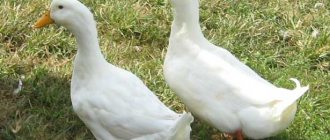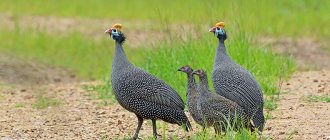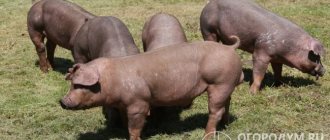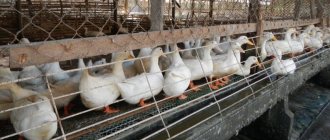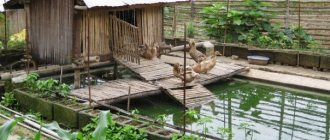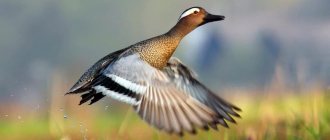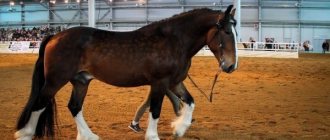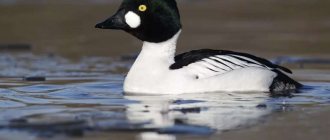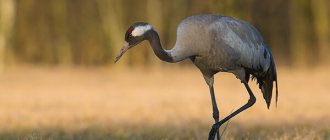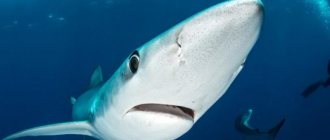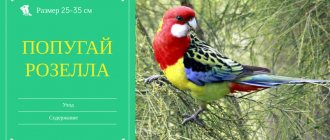The Ogar is a bright and distinctive red waterfowl that breeds in south-eastern Europe and Central Asia, migrating to South Asia for the winter.
Its bright rufous plumage contrasts with its pale cream head and neck. In captivity they are kept for ornamental purposes due to their bright plumage.
They are usually aggressive and uncommunicative; it is better to keep them in pairs or disperse them over long distances. If you keep the Scorchfish together with ducks of other breeds, then in this case they become very aggressive during the nesting period.
Origin story
Photo of the breed:
The Shelduck (Tadorna ferruginea), along with the shelduck, is a member of the genus Tadorna, in the family Anatidae (anatidae).
The bird was first described in 1764 by German zoologist/botanist Peter Pallas, who named it Anas ferruginea, but it was later transferred to the genus Tadorna.
In some countries it is placed in the genus Casarca along with the South African grey-headed shelduck (T. cana), Australian shelduck (T. tadornoides) and New Zealand shelduck (T. variegata).
Interesting fact: Phylogenetic DNA analysis shows that the species is most closely related to the South African schard.
The genus name Tadorna comes from the French "tadorne" and possibly originally from the Celtic dialect meaning "motley waterfowl". The English name "sheld duck" dates back to around 1700 and means the same thing.
The species name ferruginea is Latin for "red" and refers to the color of the plumage. One of the Kazakh fairy tales says that rarely, once every few hundred years, a Tazy puppy hatches from an egg. Anyone who finds such a puppy will have good luck in all his affairs.
Description
Photo:
Ogar - has become a fairly recognizable duck due to its special bright red color. All the closest relatives living in the southern hemisphere and having red patches in their plumage differ in the color of their heads.
Appearance and features:
- The Ogar grows to a length of 58-70 cm and has a wingspan of 115-135 cm, and its weight is 1000-1650 g.
- The male has orange-brown body plumage and a paler, orange-brown head and neck, which is separated from the body by a narrow black collar.
- The flight feathers and tail feathers are black, and the inner surfaces of the wings have iridescent green shiny feathers.
- The upper and lower wings have a white underwing, this feature is especially noticeable during flight, but is barely visible when the bird is just sitting.
- The beak is black, the legs are dark gray.
- The female is similar to the male, but has a rather pale, whitish head and neck and lacks a black collar, and in both sexes the coloring is variable and fades as the feathers age.
- Birds moult at the end of the breeding season. The male loses his black collar, but further partial molting between December and April restores it. The chicks look similar to the female, but are a darker shade of brown.
- The Ogar swims well, and in flight it looks heavy, like a goose.
- A dark ring on the neck appears on the male during the nesting period, and females often have a white spot on the head.
- Bird call - consists of a series of loud, nasal honks, similar to a goose. Sound signals are given both on the ground and in the air, and vary depending on the circumstances under which they are made.
Distinctive characteristics
The Ogar is a bit like a goose, but has differences and characteristic behavior. The wild duck has a large body, long legs and neck. The sounds that the red wild duck makes are similar to the cackling of a goose. These birds can make sounds on the ground and in the air. Drakes make rhythmic sounds, and ducks make drawn-out sounds. A distinctive characteristic of birds is that they live in pairs. They do not require a large pool to maintain them. Ogars swim and dive well, run and fly quickly. After the formation of a pair, the drake actively defends the nest, even attacking relatives.
Habitats
Populations of this species are very small in northwestern Africa and Ethiopia. The main habitat of the ogre extends from southeastern Europe through Central Asia to Lake Baikal, Mongolia and western China.
The eastern populations mainly migrate and winter in the Indian subcontinent.
The species colonized the island of Fuerteventura in the Canary Islands, first breeding there in 1994 and reaching almost fifty pairs by 2008.
In Moscow, individuals of the Scorch released in 1958 created a population that numbered 1,100.
Unlike other representatives of this species in Russia, these red ducks do not migrate to the south, but return during the winter to the territory of the zoo, where all conditions have been created for them.
The main habitats are in:
- Greece;
- Bulgaria;
- Romania;
- Russia;
- Iraq;
- Iran;
- Afghanistan;
- Turkey;
- Kazakhstan;
- China;
- Mongolia;
- Tyva.
The ogary is a common winter visitor to India, arriving in October and leaving in April. The typical habitat of this duck is large wetlands and rivers with mud flats and pebbly banks.
Ogar is found in large numbers on lakes and reservoirs. Breeds in high mountain lakes and swamps in Jammu and Kashmir.
Outside the breeding season, the duck prefers lowland streams, slow rivers, ponds, meadows, swamps and brackish lagoons. It is rarely found in forested areas. Although the species is more common in the lowlands, it can live at higher altitudes, in lakes at an altitude of 5000 m.
Even though the squid is becoming quite rare in southeastern Europe and southern Spain, the bird is still widespread throughout much of its Asian range.
Perhaps it is these populations that give rise to vagrant individuals that fly as far west as Iceland, Great Britain and Ireland. The wild fire is successfully bred in several European countries.
In Switzerland it is considered an invasive species that threatens to displace native birds. Despite actions taken to reduce numbers, the Swiss population increased from 211 to 1,250.
Now you know where the cinder lives, let's see what a duck eats in its natural environment.
7Facts about the fire
- Ogar ducks live in pairs or small groups. More than 8 do not gather, but if the journey is long, then the company consists of 60 individuals. The character is not easy; they cannot get along with other brothers. Especially at the time of nesting, intrusion into the territory they have developed is very painful.
- The duck family firmly adheres to Clara Zetkin's idea. The female red burnt chooses a partner and dances in front of him. The future “head of the family” stands with his head down and his wings down. When the lady is confirmed in her choice, the birds rise into the sky and circle.
- Ogar probably rarely makes a mistake in his choice, because... couples stay together for more than one year. Ducklings are hatched. The clutch consists of an average of 8 eggs. Incubation lasts 28 days, chicks are born one at a time: one per day.
- The protection of the nest lies entirely on the strong male wings. The drake has incredible courage, capable of attacking larger birds, such as the white-tailed eagle and humans. We must remember that the fire has teeth!
- The cinder ducklings stay in the nest for 4 weeks. At 8 weeks they become independent. Although red ducks create pairs by the age of 2 years. And they use this time to travel, in general, they live for themselves.
- Red ducks make nests quite unexpectedly, and they use them for many years. One of the options is rocky shores, rock crevices, old stacks of straw and in hollows. Yes, the common duck loves heights; they can climb up to 10 meters.
- Another option, the most dangerous. The hole can serve as a nest. It is very important to note that the hole is used by steppe animals - foxes, corsacs, steppe cats. The scorched duck, having occupied a warm, familiar place, makes a loud sound similar to the hissing of a snake. In case the owner wants to return his lair.
What does it eat?
Ogar feeds mainly on plant foods, sometimes animals, giving preference to the former. The proportions of food intake depend on the area where it is located and the time of year.
Food intake is carried out on land and on water, preferably land, which significantly distinguishes the red duck from the closely related shelduck.
Favorite food products of plant origin include:
- herbs;
- leaves;
- seeds;
- stems of aquatic plants;
- corn;
- vegetable shoots.
In the spring, the cinder tries to forage on lawns and between dunes, looking for green shoots and seeds of grasses such as saltwort or cereals.
During the breeding season, when offspring appear, birds can be seen on salt licks hunting for insects (mainly locusts).
On lakes it feeds on invertebrates such as worms, crustaceans, aquatic insects, as well as frogs + tadpoles and small fish.
By the end of summer and autumn, the firebug begins to fly into fields sown with winter crops or already harvested, in search of seeds of grain crops - millet, wheat, etc.
They happily eat grain scattered on the roads. They may visit garbage dumps. There are known situations when these ducks, like crows and other birds, even ate carrion. Ducks search for food more actively at dusk and at night, and rest during the daytime.
Nutrition
Ogars feed on both plant and animal foods. The plant menu consists of grass, young shoots, grains and seeds. The red duck hunts insects, crustaceans, larvae, mollusks, fish and frogs. So the firefish has adapted to get food both in water and on land.
In autumn, agricultural lands become the main source of food for these birds. They collect the remaining grain left after the harvest. Ducks go on such forays mainly at night; during the day they rest.
Character and lifestyle
The gorse is found in pairs or small groups and rarely forms large flocks. However, aggregations during wintering or molting on selected lakes or slow-moving rivers can be very large.
Red ducks are clumsy on the ground due to the special position of their legs on their bodies. Their paws are placed far back, making walking difficult. However, this morphology makes them exceptionally fast and agile in the water.
They can dive or submerge themselves in water without much effort. These ducks, propelled by a single movement of their legs, dive about a meter below the surface until they reach the substrate where they forage for food.
During a dive, the legs paddle simultaneously while the wings remain closed. To get into the air, these ducks must beat their wings quickly and run across the surface of the water. The ogre flies at relatively low altitudes above water.
Interesting fact: The staghorn does not actively defend territory and does not limit itself to a specific home range during any part of the year.
They rarely interact with other birds, and juveniles tend to be aggressive towards other species.
The maximum lifespan of red ducks in the wild is 13 years.
However, according to the Global Invasive Species Database, these ducks, when trapped and tracked in the wild, rarely survive past 2 years. Birds kept in captivity have an average lifespan of 2.4 years.
About the chicks
Little chicks of schards are deprived of parental care 2 months after hatching. As soon as the ducklings leave the nest, they head to the pond, accompanied by their mother, and immediately begin to swim. They return to the nest only to spend the night. Both parents care for the babies equally.
An interesting fact is that when a brood appears on the pond, the parents become even more furious. Usually the female is next to the chicks, while the male at this time creates a certain boundary around his family, where he does not allow anyone to enter. And he pinches those who do not understand and the unwary, beats them with his wings and plunges them into the water, grabbing them by the wing with his beak. Around the 55th day, the young begin to fly and stop needing care.
This species of duck reaches sexual maturity only in the 2nd year of life, and nesting begins immediately.
Productivity
Female cinders occupy a leading position in egg production compared to other species. The first eggs are obtained from them already at 6 months of age.
One female lays up to 120 eggs per year. If cinders are raised for breeding, then each egg will hatch into a healthy and strong duckling.
With good nutrition at home, the weight of the male reaches 6 kg, the female - 4 kg.
Importance in the economy
The commercial value of this bird is small.
In addition to being kept in local areas as a decorative pond decoration, the Smoldering duck also brings other benefits. The duck is the leader in egg production compared to other domesticated birds. A female can lay about 120 eggs per year. And most likely, from all these eggs, healthy babies can be born with virtually no loss.
If desired, poultry can also be used to produce dietary meat.
These ducks gain weight very well. Their meat is especially valuable in the summer, when they waste fat while walking on a variety of plant foods (the meat of the wild scorch is not very tasty, perhaps this is due to the fact that the bird sometimes feeds on carrion).
The thick plumage of the duck is also of interest. She, too, like other birds, has warm and light feathers. They can be used in the production of warm outerwear and blankets.
Social structure and reproduction
The birds arrive at their main breeding grounds in Central Asia in March and April. There is a strong pair bond between the male and female and they are believed to mate for life.
In their breeding grounds, the birds are very aggressive towards their own species and other species. The females, seeing the intruder, approach him with a bowed head and an outstretched neck, uttering angry sounds.
If the intruder stands still, she returns to the male and runs around him, inciting him to attack.
Mating occurs on the water after a short mating ritual involving neck stretching, head touching and tail raising.
Nesting sites are often far from water in a hole, in a tree, a destroyed building, in a rock crevice, among sand dunes or in an animal burrow. The nest is built by the female using feathers and down and some grasses.
A clutch of eight eggs (six to twelve) is laid between late April and early June. They have a dull luster and creamy white color, averaging 68 by 47 mm. Incubation is carried out by the female, and the male is nearby.
The eggs hatch in about 28 days and both parents care for the young, which will fly away in another fifty-five days.
Before molting, they move to larger bodies of water where they can more easily avoid predators while they are not flying.
Interesting Fact: Female Scorchfish invest heavily in their chicks. From hatching until 2-4 weeks of age, the female is very attentive to the brood.
She stays close while feeding and also exhibits aggressive behavior when ducks of other ages approach. Females also reduce their diving time while the young brood dives with her to monitor and protect the chicks.
The family may stay together as a group for some time; autumn migration begins around September. North African birds breed about five weeks earlier.
General information about origin and distribution
Where is the Ogar duck found? The deserts of Africa and the steppe expanses of Europe are considered its homeland. These birds have also been found in small numbers in Central Asia, and they constantly migrate throughout China, India and Taiwan.
In nature, the wild red bird is distributed to a greater extent in the zone of deserts and steppes - from the coasts of the Black Sea to Transbaikalia (South-East), and north to Lake Baikal and forest-steppes. The wild duck ogar does not settle in taiga territories and in areas with dense vegetation.
In Russia they are found almost everywhere. The first specimens of ducks were brought to Moscow zoos in the 1920s, where they began to quickly multiply and spread throughout the reservoirs of many park and green areas of the city. Due to their bright appearance, ducks undoubtedly adorn lakes and ponds. They have adapted perfectly to urban conditions, feel quite comfortable and are not afraid of people.
Ogars inhabit numerous and varied inland bodies of water throughout the country.
Natural enemies
The firefish's ability to dive below the surface of the water allows them to avoid many predators.
During the breeding season, they build nests using surrounding vegetation, which provides cover and camouflage for protection from predators that prey on eggs and ducklings.
Females often try to distract predators from nests by leading them away. Their eggs are proportionally the largest of any waterfowl.
Eggs and chicks are hunted by predators such as:
- raccoons (Procyon);
- mink (Mustela lutreola);
- gray herons (Árdea cinérea);
- common night herons (Nycticorax nycticorax);
- seagulls (Larus).
Ogar spends most of his time on the water. They are fast fliers but have little maneuverability in the air, and so tend to swim and dive rather than fly to escape predators.
They are very aggressive towards each other and other species, especially during the breeding season.
Known predators that prey on adults include:
- raccoons (Procyon);
- mink (Mustela lutreola);
- hawks (Accipitrinae);
- owls (Strigiformes);
- foxes (Vulpes Vulpes).
Humans (Homo Sapiens) also legally hunt red ducks throughout almost their entire distribution range. Although they have been hunted for many years, and numbers have likely declined over that time, they are not very popular among hunters today.
Ogar are heavily dependent on wetlands, but grazing, burning and draining of wetlands have led to the deterioration of their habitat conditions.
Owner reviews
Igor, 48 years old, Altai region
I have long wanted to have red ducks - they are a very beautiful bird, judging by the descriptions and photos. I had to look. I took young animals, only 6 individuals. They are easy to care for and feed well on the lawn near the house and on the small pond located nearby. They look like bright tangerines or orange floats on the water. I've trimmed the wings so they don't fly away. In the spring it was very interesting to watch their “love”, but at this time it is better not to approach them - they raise a terrible cry and hubbub, the drake rushes to attack, is not afraid of anyone.
Galina, 56 years old, Astrakhan
I keep 2 pairs of adult half-geese-slags for my own enjoyment. They are exemplary parents; while the female incubates the clutch, the male is always with her. After hatching, the chicks, as soon as they are dry, go together after the adults to the river, run quickly, in a row, and grab all sorts of midges and fleas along the way. The bird itself is bright and catchy, and the duckling is black and white to hide better.
Maxim, 34 years old, Kherson
I took several young ducks for eggs and meat. They are not capricious in keeping and feeding. They lay properly, the eggs are large. Sometimes I use a cinder instead of an incubator, placing eggs of ducks of other breeds that do not show a desire to incubate.
Breeding
Raising red ducks is not a difficult task. It is enough to know a few basic rules.
Incubation or natural brooding?
Females are distinguished by good maternal instinct, so private farms do not use incubators for breeding ducklings. Moreover, after hatching, the parents, both the female and the male, constantly look after the brood, protect it from enemies and teach it the wisdom of life.
Care and maintenance of chicks
Parents easily cope with their responsibilities and do not let the chicks out of sight 24 hours a day. Human assistance in caring for babies is reduced to a minimum.
It is necessary for them to moisten the floor in the room using damp burlap. It is placed on the floor, and straw and sawdust are poured on top.
Feeding the chicks
The chicks are fed with a special feed - starter, intended specifically for ducklings. To enrich them with vitamins, they are given finely chopped spinach, lettuce, duckweed, nettle, as well as protein food in the form of small insects and earthworms.
Be sure to ensure that there is always fresh water in the babies' drinking bowls.
The ducklings are fed immediately after they are dry. In nature, babies react only to movement, so their main food at this time is flying and crawling insects.
You can attract their attention to the feeder by tapping on it. If the duckling refuses food for several hours, it is force-fed with a liquid mixture from a pipette.
It consists of boiled yolks and milk. Ducklings are fed 4-5 times a day. Be sure to add crushed chalk, shell rock and fine sand to the food.
Habits
Like ordinary ducks, the ogre does not know how to quack in the traditional sense.
This bird is noisy throughout the year. Its characteristic vocalization, comparable only to the voice of the Canada goose, vaguely resembles the neighing of a domestic donkey. The most common sound made in flight and on the ground is the sonorous "gang" or "ang", and sometimes it is stretched over two syllables, so it sounds like "waak" or "aak". After the end of such a cry, a dull trill is often heard. Females and males make distinct sounds: the female’s voice is sharper, louder and deeper, and the sound “a” predominates in it.
In general, the duck's character is hot-tempered and quarrelsome. Usually males are defenders of their territory, where other waterfowl are not allowed. They even start serious fights - this is how they drive out competitors. They gather only in small groups of several pairs due to their intolerance towards strangers.
These ducks adapt well to cold climates. They winter without much difficulty in the ice-free reservoirs of parks.
Care and maintenance of Ogar
Since scorches do not like to be in a large, “different-feathered” company, it is necessary to ensure that each pair has its own separate territory.
A small lawn and a pond must be available for walking. At the same time, they do not require large water surfaces. Otherwise, the birds will not build nests and reproduce.
During winter frosts, they are kept in dry, enclosed areas, but separately from other breeds, so that mixing does not occur and hybrid ducklings do not result. In the end, this all leads to the complete breeding of the genus.
Ogars have excellent immunity. With proper care, they are not susceptible to disease. They are only vaccinated against viral hepatitis.
Poultry house arrangement
A warm floor is made in the winter poultry house, for example, by laying a thick layer of bedding - sawdust or straw.
In it, birds will warm themselves from the winter cold and lay eggs. The room temperature should be +7°C or higher.
In summer they are kept in an enclosure. The required area for one pair is 1.5-1.7 square meters. m. They also build a small house in it so that in unfavorable weather conditions they can take refuge in it.
If there is no natural body of water nearby, you will have to get an artificial pool.
Ogars are unpretentious birds with strong immunity. Basic care consists of:
- in timely change of litter;
- maintaining cleanliness and dryness in the barn;
- increasing daylight hours in winter using artificial lighting;
- in the constant availability of clean, fresh water in the drinking bowl.
Poultry house arrangement
At the time of the first frost, the shelduck is moved to a closed bird house with a flooring of straw and wood sawdust, which is usually located next to the aviary. In winter, the temperature in the place where the birds will be kept should not be below +6 degrees. The correct ultraviolet distribution system is also important.
Additional Information! Ducks become more productive and lay more eggs when they get adequate amounts of vitamin D.
In winter, you can increase daylight hours in the morning and early evening, including additional light for birds. A small house on the ground is an ideal place for ducks to nest. The poultry house can be made from chipboard. It should also have a threshold and possibly small windows (like in a prison, blocked by a mesh).
Population and species status
Buddhists consider the red duck sacred, and this gives it some protection in central and eastern Asia, where the population is considered stable and even increasing.
The Pembo Nature Reserve in Tibet is an important winter area for sardines, where they receive food and protection. In Europe, on the other hand, numbers tend to decline as wetlands are drained and birds are hunted.
However, they are less vulnerable than some other waterfowl due to their adaptability to new habitats such as reservoirs, etc.
Interesting fact: In Russia, in its European part, the total number of skellies is estimated at 9–16 thousand pairs, in the southern regions - 5.5–7 thousand. Flocks of up to 14 individuals were recorded during the winter on the Black Sea coast.
The firebug has a wide distribution range, and, according to experts, the number ranges from 170,000 to 225,000. The overall demographic trend is unclear, as population numbers are increasing in some places and decreasing in others.
Interesting facts about cinders
If you watch scorched ducks, you will notice several interesting and unusual facts:
- Birds like to rest and walk around bodies of water in groups of three or four pairs.
- The red-headed duck also feels comfortable in small bodies of water.
- During the mating season, the male gorse remains on the sidelines; it is the female who makes the choice.
- On the water, the firebird behaves aggressively, causing squabbles and violent fights with drakes.
- During puberty, the male gorse changes its plumage, a dark circle appears around the neck, and the red color becomes faded.
- During the fertilization period, the duck blossoms and white circles appear around the eyes.
